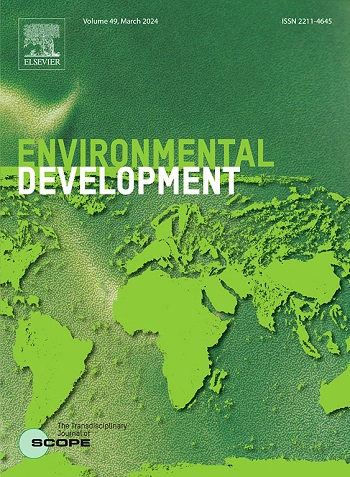Multiscale eco-hydrological zoning in the Yarlung Zangbo River Basin, Qinghai–Tibet Plateau, China
IF 5.3
2区 环境科学与生态学
Q2 ENVIRONMENTAL SCIENCES
引用次数: 0
Abstract
Eco-hydrological zoning is a key challenge in eco-hydrology. Large-scale principal component and clustering fail to capture eco-hydrological coupling or support adaptive management. Multiscale eco-hydrological zoning enables refined, coordinated regional management of ecosystems and water resources. Taking the Yarlung Zangbo River Basin as an example, we quantified the eco-hydrological index (EHI) through entropy and catastrophe progression methods and divided into three eco-hydrological zones: a low-water, a normal-water and a multi-water from 2000 to 2020 integration of five scales, and analyzed drivers of zones with the Optimal Parameters-based Geographical Detector (OPGD) and Partial Least Squares–Structural Equation Modeling (SEM). The results showed that (1) the low-water zone aligned with sandy land, bare rock, and permanent ice/snow; the normal-water zone correlated with alpine grasslands and the multi-water zone matched alpine wetlands and forests. (2) Over the 20-year period, eco-hydrological zoning pattern overall remained stable, normal-water ecological zone averaged 56.98 %, the low-water and the multi-water ecological zones averaged 18.15 % and 24.87 %, increased 0.18 % and 0.39 %. (3) GDP and vegetation cover were the primary driving factors influencing EHI with the interactions between driving factors primarily characterized by double-factor enhancement, and synergistic effects between drivers substantially exceed their individual contributions. (4) Ecological and topographic factors were positively correlated with EHI, while human activities, climate and hydrology factors were negatively correlated with EHI. Topography indirectly influenced EHI by shaping climate and affecting human activities. The eco-hydrological zoning of Nature reserves and Ecological red lines offers direction for the protection, monitoring, and ecological restoration of protected areas.
生态水文区划是生态水文学研究的关键问题。大规模的主成分和聚类不能捕捉生态水文耦合或支持适应性管理。多尺度生态水文区划能够对生态系统和水资源进行精细、协调的区域管理。以雅鲁藏布江流域为例,采用熵值法和突变级数法对流域生态水文指数(EHI)进行量化,并基于5个尺度将流域划分为低水位、正常水位和多水位3个生态水文带,利用基于最优参数的地理探测器(OPGD)和偏最小二乘结构方程模型(SEM)分析了流域生态水文指数变化的驱动因素。结果表明:(1)低潮区以沙地、裸岩、永久冰雪为主;正常水区与高寒草原相匹配,多水区与高寒湿地和森林相匹配。(2) 20年期间,生态水文区划格局总体保持稳定,常水生态区平均占56.98%,低水和多水生态区平均占18.15%和24.87%,分别增加0.18%和0.39%。③GDP和植被覆盖是影响EHI的主要驱动因子,驱动因子之间的相互作用主要表现为双因子增强,驱动因子之间的协同效应大大超过各自的贡献。(4)生态因子和地形因子与EHI呈正相关,人类活动因子、气候因子和水文因子与EHI呈负相关。地形通过塑造气候和影响人类活动间接影响EHI。自然保护区生态水文区划和生态红线为保护区的保护、监测和生态修复提供了指导。
本文章由计算机程序翻译,如有差异,请以英文原文为准。
求助全文
约1分钟内获得全文
求助全文
来源期刊

Environmental Development
Social Sciences-Geography, Planning and Development
CiteScore
8.40
自引率
1.90%
发文量
62
审稿时长
74 days
期刊介绍:
Environmental Development provides a future oriented, pro-active, authoritative source of information and learning for researchers, postgraduate students, policymakers, and managers, and bridges the gap between fundamental research and the application in management and policy practices. It stimulates the exchange and coupling of traditional scientific knowledge on the environment, with the experiential knowledge among decision makers and other stakeholders and also connects natural sciences and social and behavioral sciences. Environmental Development includes and promotes scientific work from the non-western world, and also strengthens the collaboration between the developed and developing world. Further it links environmental research to broader issues of economic and social-cultural developments, and is intended to shorten the delays between research and publication, while ensuring thorough peer review. Environmental Development also creates a forum for transnational communication, discussion and global action.
Environmental Development is open to a broad range of disciplines and authors. The journal welcomes, in particular, contributions from a younger generation of researchers, and papers expanding the frontiers of environmental sciences, pointing at new directions and innovative answers.
All submissions to Environmental Development are reviewed using the general criteria of quality, originality, precision, importance of topic and insights, clarity of exposition, which are in keeping with the journal''s aims and scope.
 求助内容:
求助内容: 应助结果提醒方式:
应助结果提醒方式:


